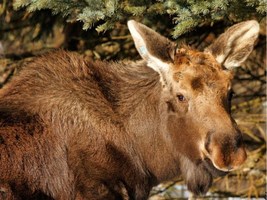No bull, Morris is about to vamoose.
The young ungulate, found orphaned last summer at Granisle, north of Burns Lake in the Northern Interior, has been nursed and cared for, and now wanders around outside the Northern Lights Wildlife Society shelter he has called home the past few months.
He roams off, comes back for a visit, roams off again, repeat -- but he will any day now heed the call of the wild, walk away, and not return.
"He comes and goes, he's still hanging around," said Angelika Langen, co-founder of Northern Lights. "As things green up, he'll be gone. I think in about two or three more weeks."
Northern Lights was established in 1989, seven years after Angelika, a riding instructor and certified animal keeper, and her husband Peter, an electrician and certified animal keeper, had emigrated from West Germany, where they had met as zookeepers in Cologne.
It took almost those full seven years to convince the province to let them set up a wildlife rehab centre. But after getting through all the red tape, the shelter has been expanding ever since.
As has the Langen family.
Today, the couple is joined by their daughter Tanja Landry (a high school teacher), her husband Shawn (a journeyman linesman and conductor for CN Rail), and that couple's young daughters Tasha and Thora. Also at the centre is their son Michael Langen (a lumber salesman), and Kim Gruijs, a certified wildlife rehabilitator from the Netherlands who first arrived in 2008 with a six-month commitment to volunteer and who returned yearly until she decided to emigrate to Canada in 2013.
The shelter specializes in black bears, deer and moose, and the grounds are excellent for allowing the latter two to gradually be reintroduced into the wild, rather than the sudden and permanent release for most rehabbed wildlife.
Today, the couple is joined by their daughter Tanja Landry (a high school teacher), her husband Shawn (a journeyman linesman and conductor for CN Rail), and that couple's young daughters Tasha and Thora. Also at the centre is their son Michael Langen (a lumber salesman), and Kim Gruijs, a certified wildlife rehabilitator from the Netherlands who first arrived in 2008 with a six-month commitment to volunteer and who returned yearly until she decided to emigrate to Canada in 2013.
The shelter specializes in black bears, deer and moose, and the grounds are excellent for allowing the latter two to gradually be reintroduced into the wild, rather than the sudden and permanent release for most rehabbed wildlife.
Most of the animals brought in are orphaned or injured by road traffic, trains, barbed wire, poaching or habitat loss.
Astrid, a female coastal mule deer, arrived as a one-week-old from Prince Rupert. Tamale was found wandering alone around Fort St. John. Skip, Sky and Cloud are male black bears, Maize, Lizzy and Kyrie are females, all orphaned after cars hit their mothers.
And then there is Morris, found wandering alone near Granisle.
"We just saw the first nose of a hibernating bear poke up through the snow," Langen said. "They started to get noisy a week ago, as soon as it greens up, we'll get (the other animals) out of here as quick as we can."
Thirty years ago, when the Langen's were green themselves, it tugged on the heartstrings every time an animal left the shelter, Langen said. "It was pretty tough. But no, not anymore.
"It's what we want, for them to be free. And with a new baby season just about here, we need the room."
She has no concerns for Morris.
"He's a very handsome moose, and he's grown quite big."



.png;w=120;h=80;mode=crop)